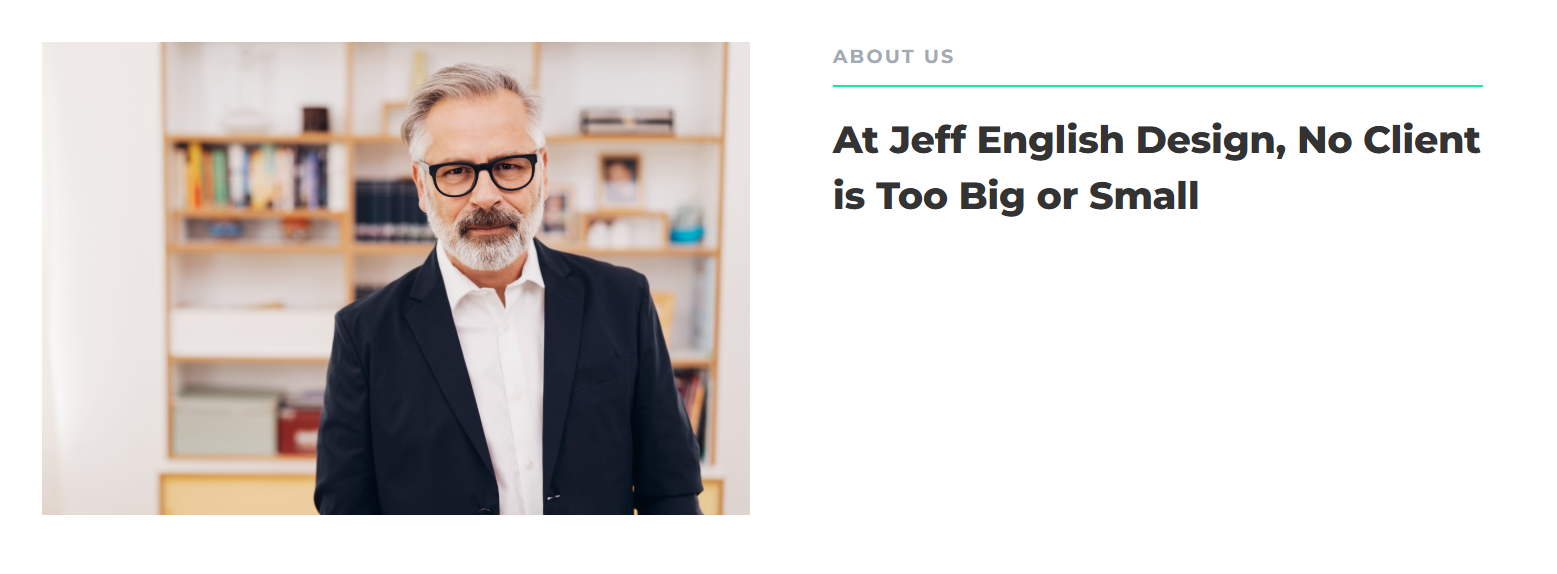Jeff English, a graphic designer based in Hoboken, New Jersey, has carved out a niche in the competitive world of creative design. His studio, nestled in the heart of Hoboken’s bustling arts district, serves as a beacon for businesses seeking fresh and innovative branding solutions. Jeff’s work spans marketing materials, brand identities, website design, and even custom apparel. Known for blending clean, modern aesthetics with compelling narratives, Jeff’s designs resonate with clients from small startups to established corporations.
Business Life
The seed for Jeff’s business was planted during his early career at a corporate design firm. One late night, while brainstorming a campaign for a major client, Jeff sketched an idea on a napkin at a local diner. The concept—a minimalist, story-driven logo—struck a chord with the client and became a hallmark of their rebrand. “That moment showed me the power of simplicity paired with meaning,” Jeff recalls. Inspired by this success and frustrated with the creative limitations of corporate life, he decided to venture out on his own.

Starting his business was no easy feat. Jeff recalls working out of his one-bedroom apartment, juggling freelance gigs while building his client base. A breakthrough came when he designed the branding for a friend’s coffee shop, which quickly became a local favorite. The project caught the attention of other small businesses in the area, giving Jeff the momentum to establish his studio.
Jeff emphasizes the importance of storytelling in design. “Every business has a story, and my job is to tell it visually,” he says. This philosophy has won him accolades and loyal clients, including local restaurants, e-commerce startups, and nonprofits.
Beyond design, Jeff mentors young designers and frequently speaks at community events. He remains deeply committed to Hoboken, often collaborating with local artists and contributing to public art projects. Jeff’s journey demonstrates how creativity, determination, and a touch of serendipity can turn a vision into a thriving business.
Early Days
Jeff grew up in Hoboken, New Jersey, a city teeming with diversity and creativity. From an early age, Jeff showed a knack for art, spending hours drawing comic book characters and sketching urban landscapes. His childhood was marked by a mix of challenges and inspirations that would later shape his journey as a graphic designer.
Jeff attended Hoboken High School, a place that fostered his artistic inclinations. Known for its vibrant extracurricular scene, the school’s art department became Jeff’s second home. One of his teachers, Ms. Carmichael, recognized his talent early on and encouraged him to submit his work to local competitions. “Jeff had this unique ability to see beauty in ordinary things,” she once said. One of his first recognitions came during his sophomore year when his design for a community mural was selected out of dozens of entries. The mural, which celebrated Hoboken’s rich cultural history, still stands today as a testament to young talent and community pride.
An important turning point in Jeff’s life came during his junior year, inspired by a conversation with his mother. His mom, Maria English, worked long hours as a seamstress to support Jeff and his siblings. One evening, as she meticulously repaired a neighbor’s dress, Jeff complained about not having enough supplies for an art project. Maria paused her sewing, looked him in the eye, and said, “Creativity isn’t about what you have; it’s about what you do with what you have.”
The next day, Jeff scavenged materials from around the house—a cereal box, leftover wrapping paper, and old magazines—and crafted a collage that won first place in a regional art contest. “That lesson stuck with me,” Jeff recalls. “It taught me to look at challenges as opportunities.”
Growing up in Hoboken also meant being surrounded by the city’s eclectic culture, from the iconic waterfront views of the Manhattan skyline to the lively street fairs. These experiences deeply influenced Jeff’s artistic style, which often incorporates bold colors and dynamic compositions reminiscent of urban life. On weekends, he would explore the city with a sketchpad in hand, drawing inspiration from the graffiti art, historical buildings, and bustling markets.
Despite financial struggles, Jeff’s family was close-knit and supportive. Maria often told him, “No dream is too big if you’re willing to work for it.” That mantra motivated Jeff to excel in school and pursue his passion for design. By the time he graduated from Hoboken High, he had already built a small portfolio of freelance work, including designing posters for local events and logos for small businesses.
France Trip Leads To Business
In 2017, Jeff English embarked on a transformative journey to France, seeking both inspiration and a much-needed break from the hustle of running his design business. The trip was supposed to be a chance to immerse himself in the art and culture of the country, but it turned out to be a pivotal moment in his career when he unexpectedly picked up two new clients.
Jeff began his adventure in Paris, wandering through the cobblestone streets and marveling at the architecture that had inspired countless artists before him. On his second day, he visited the Louvre Museum, where the grandeur of the exhibits left him in awe. It was in the museum café that Jeff struck up a conversation with an expatriate entrepreneur named Sophie.
Sophie, who ran a boutique travel agency specializing in custom European tours, was immediately intrigued by Jeff’s design expertise. She mentioned needing a rebrand for her agency, and Jeff offered to sketch out a few concepts on the spot using his tablet. “I wanted something modern but still rooted in European elegance,” Sophie later said. Within days, they had finalized an agreement for Jeff to develop her new logo and website design.
After a week in Paris, Jeff traveled to Provence, where the lavender fields and charming villages offered a completely different kind of inspiration. One afternoon, while sketching at a local café, Jeff met Jacques, a vintner who owned a small but prestigious winery. Jacques explained that his winery was struggling to stand out in the competitive French wine market, especially among younger consumers. Jeff shared his ideas on modern branding and how digital storytelling could highlight the winery’s unique history. Jacques was impressed enough to invite Jeff for a tour of the vineyard the following day, and by the end of the visit, they had agreed to collaborate on a branding overhaul that would include new labels and a social media campaign.
Beyond these professional opportunities, the trip reinvigorated Jeff’s creative spirit. He filled his sketchbook with scenes of French marketplaces, countryside vistas, and bustling Parisian streets. “France reminded me why I became a designer in the first place,” Jeff said. “It’s about telling stories that connect people to something bigger than themselves.”
When Jeff returned to Hoboken, his portfolio now included international clients, giving him a competitive edge in the design industry. His trip to France wasn’t just a personal escape; it became a defining chapter in his career, blending his love for travel, culture, and design into a new and exciting direction.
Credo
Jeff has built his business on three foundational life lessons, which he applies to every client interaction and project.
First, he emphasizes the importance of listening. Jeff believes that truly understanding a client’s vision begins with hearing their story and goals. As he often says, “Good design doesn’t start with a pen; it starts with an open mind.” This approach has helped him build trust and foster long-lasting partnerships.
Second, he values adaptability. Whether working with local startups or international clients like those he met in France, he has learned that flexibility is key. “Every project comes with its own challenges,” he says, “but being willing to pivot ensures success.”
Finally, he prioritizes authenticity and passion in his work. Growing up in Hoboken, his mother taught him to approach every task with genuine care, a lesson that still resonates today. He credits this mindset for helping him create designs that not only meet client needs but also leave a lasting impression.
These principles have guided his career, allowing him to thrive in the competitive design world while staying true to his values. For Jeff, success isn’t just about business; it’s about creating meaningful connections and work that inspires.

